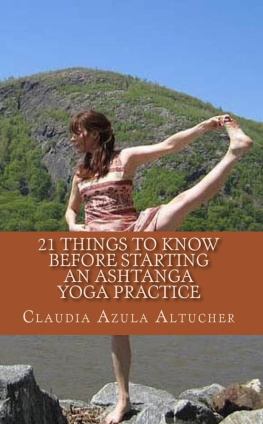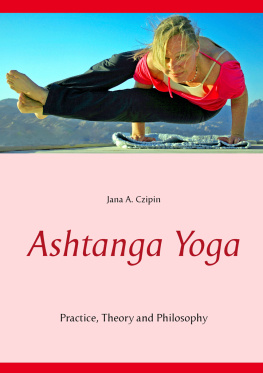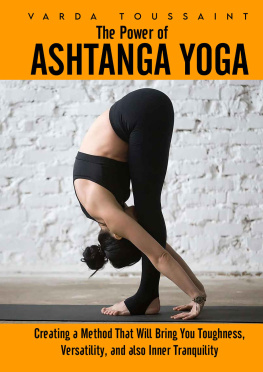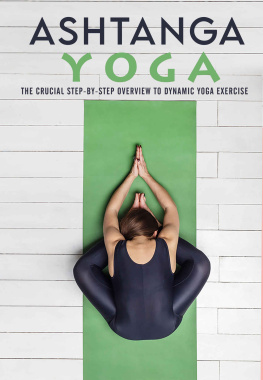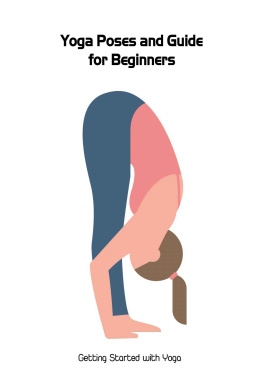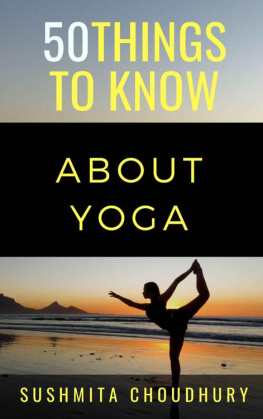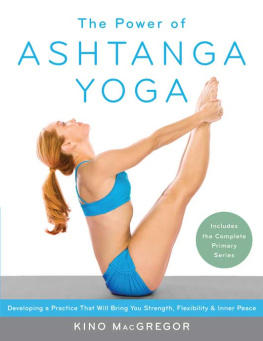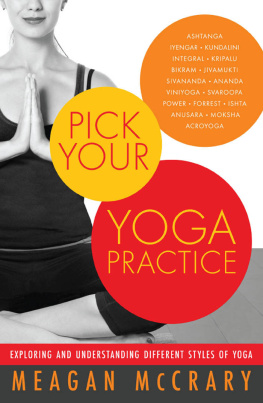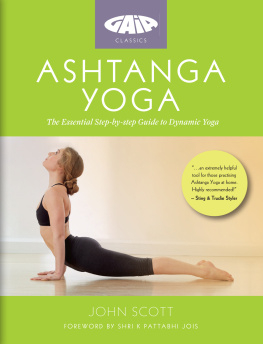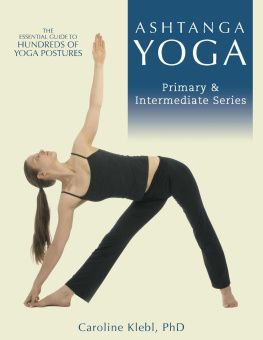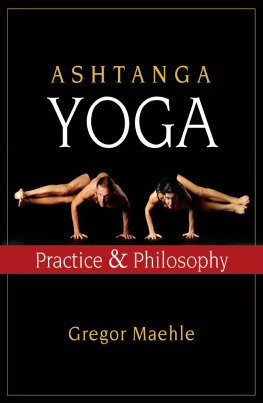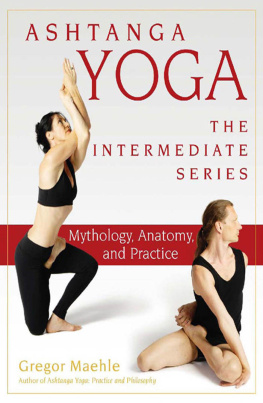
Copyright 2011 Claudia Azula Altucher
All rights reserved.
ISBN 10: 1461147743
ISBN-13: 978-1461147749
eBook ISBN: 978-1-61397-483-4
DEDICATION
To James, I love you
CONTENTS
Before I even met Claudia (on our very first date) I knew that she was into yoga and that yoga was her life. For me this was sexy.
In my feeble understanding of what yoga meant I knew that Claudia was going to be healthy (or at least making a serious attempt at living a healthy life). I knew that she probably cared how she looked (dont all yogis look beautiful and sexy, I thought?) and I knew that she probably had a spiritual side to her quest for a better life.
I was right on all counts. Then, towards the end of our first date, Claudia said: so when do you start yoga?
Whoah! Let me get back to you on that one.
But it was true, I needed to live a healthier life myself. We started dating and I knew I had to keep up. I started working out in a gym with a trainer. I was doing weights. But I was reading Claudias blog and I was getting attracted to some of the philosophical aspects.
James is a yogi Claudia would tell her friends, but he doesnt know it yet. And everyone would laugh. Me, most of all.
But then I got on the mat in August, 2010. Then we went to India in January 2011 and I started studying more intensively. I got into not only the physical practice but I was reading every book I could find on the spiritual practice. I felt my life improving.
My only regret now: is that I hadnt read this book and started sooner. The only problem with that is that this book didnt exist until today. Fortunately, you dont have that problem
James Altucher
I bow to the lotus feet of the Teacher, Sharath Jois, of Mysore, India, current head of the Ashtanga Yoga Research Institute
And to his mother Saraswathi Rangaswamy, and her brother Manju Jois who carry the light of Ashtanga yoga by teaching all over the world
And to their Teacher before, Sri Krishna Pattabhi Jois, who said: Do Your Practice And All Is Coming
And his teacher before him, Sri Tirumalai Krishnamacharya, who said: Propagate Yoga Wisely
And his Teacher before him, Sri Ramamohan Brahmachari
And to all the teachers and gurus that came before them.
May this book be a channel for their wisdom to reach further students. May the world become a more peaceful place as a result. May we all be well.
ONE: WELCOME AND AN
INTRODUCTION
May we all practice Ashtanga Yoga which brings peace to our minds and to the world.
Sharath Jois, NYC, April of 2011
Within just a few years the practice of Ashtanga Yoga has made me physically, emotionally, and mentally healthier. It is with deep gratitude and excitement that I set out to write this book in the spirit of sharing.
I am a beginner, which by Ashtanga Yoga standards means I have not practiced daily asanas (poses) six times a week-, non-stop, for over 10, 12, 15, 30, 50 or 70 years. Depending on whom you talk to you will get a different point of view on what being a beginner means. I find that we are all beginners unless we have practiced steadily for a very long time, and in this tradition a long time means long.
I only discovered the Ashtanga Vinyasa Yoga style of Pattabhi Jois in 2004.
I am scared of writing this book. I am scared that I do not have 40 years of experience nor know how to speak Sanskrit. I am afraid because I cannot chant all of the Yoga Sutras from memory or fully place both legs behind my neck.
Yet, it is exactly the hunger produced by the fact that I am a beginner that inspires me to write it right now, before I cross that line that turns me into a more experienced practitioner or someone who just does not remember what it is like to get started.
I am telling you all of this for two reasons 1) so that you know, and 2) so that you know what to expect. This book is intended as a guide, a resource, and a conversation.
When I first started practicing I always wished I had a handbook that directed me and gave me pointers as of where to start, what to focus on first, who to ask the questions I had, how to go about those first practices, whether to travel to Mysore or not, how much would my life change? I wanted an overview or a guide.
Recently someone who has been attracted to this practice asked at the blog if I could provide such a guide because it all felt very intimidating from the perspective of a beginner. I completely related. That is how this book was born. It is the book I wished I had, and I felt inspired to write it.
I noticed that sometimes advanced students - people who have been practicing for, say, 15 or more years- tend to forget the struggles of getting used to a whole new and demanding practice like this one, and although I am not a complete beginner anymore as I have been on the mat for a few years, I happen to be married to someone who is. Watching his progress and drawing from my own experience I put together these 21 points to serve as a guide for anyone who is curious about this fascinating process.
Lets get to it.
What is Yoga?
To actually understand this [the definition of yoga] in ones being is of a wholly different order. To understand words and concepts is easy, but to let the experience of yoga penetrate deep into ones heart, to realize fully what one is made of, and, finally, to establish the mind in the Selfthese are very difficult
Sri K. Pattabhi Jois
Yoga happens when we can be present in this moment without the mind running a script that describes what it thinks is happening and tries to figure out what is in it for her. That is what the very first line of the Yoga Sutras of Patanjali (the bible of yoga) tells us: Yoga is the cessation of the fluctuations of the mind. Sometimes I prefer the term delusions instead of fluctuations, it seems to bring the point home more clearly, as we go through life thinking that we know everything and that our mind can control things, when in reality we live in an eternal now, full of possibilities, and whatever we may think we know is just one point of view.
The basic translation from the Sanskrit term yoga tells us that it means to yoke, or to unite. So we unite body mind and spirit. The problem with this definition is that it is too broad, as in: What does that mean?
Intellectually I can understand it, but as I go down the street, how do I use the yoking idea to live a yogic life? Sri K. Pattabhi Jois, the man who named the style Ashtanga (which means eight limbs) says in his book Yoga Mala that yoga is: a path we follow by which we can attain something and that something we are trying to attain is the Self.
This is a great definition and as the pieces of the puzzle begin to be put together through steady practice and for a long time it will eventually make sense, however, for someone just coming into yoga it might be a bit confusing to just grasp what he means by Self.
This Self is the part of us that is always at peace, the part that was never born and will never die, the part that is timeless, eternal, always flowing in this moment, free of compulsive thinking.
For many of us this being fully present is not possible right away as it is stated on that first yoga sutra, the mind has too much momentum, the collective thinking has a tremendous power of hypnosis over us. And so, when just being present does not work, some of us want a path to follow, steps, guidelines, and that is where the second chapter of the yoga sutras comes handy.
Patanjali gave a very clear three point description of how we can all achieve the state of yoga. He said we can gain it by doing these three things:
Next page
